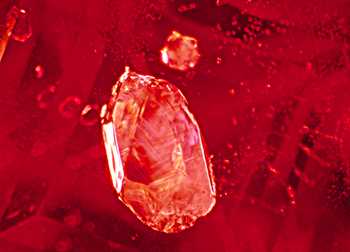Video explanation between unheated ruby vs lead glass-filled ruby (composite ruby):

The second video shows different ruby treatments under a microscope

WHY KNOWING ABOUT RUBY TREATMENTS IS IMPORTANT?
Before buying any ruby it is important to know what type of treatment it has gone through.
Natural Rubies have different levels of treatment.
- Natural (no treatment)
- Heat Treatment to enhance color
- Heat Flux Treatment to enhance color and clarity
- Lead-Glass filled Treatment to change characteristics of a ruby
The more treatment the ruby goes through the lower the price gets!
The price can range from exceptionally expensive US$10,000+ per carat for unheated, natural rubies to US$5 per carat for lead-glass filled rubies.
Glass-filled rubies have flooded the gem market from traditional retail stores, online websites to sellers on eBay.
Simply checking the authenticity of the certificate and understanding the ‘treatment’ section, you can save thousands of dollars. This will also save you time and the harassment of getting scammed by the seller due to them not disclosing these facts to you.
I hope this guide will provide you with a basic understanding of the different types of ruby treatments.
I do want to emphasize that even if you read this guide, it does take years of experience seeing rubies to understand the different levels of treatments.
If there is any doubt about your purchase – “Even that slight 1% chance” – it is always best to recheck the stone from a reliable gemstone laboratory or trustworthy gem dealer.
RUBY TREATMENT GUIDE – UNHEATED, UNTREATED, COMPLETELY NATURAL RUBY
Natural Ruby that are NOT heated or treated are quite easy to check. You will only need to see through a microscope or gem loupe for natural or intact inclusions.
Natural Inclusions Are:
- Intact, fine, needle-like Silk (rutile needles) intersecting at 60 degrees angle. In the same plane or other fine needles at near right angles.
- Boehmite needles
- Fingerprint inclusions
- Angular, straight, or hexagonal growth zoning or banding
- Straight, angular, and possible color zoning and color banding
- Unaltered mineral inclusions, clear or opaque color, that might show angular faces
- Intact two-phase inclusions
Below are some sample images of rubies with these characteristics. Please note that it does take some experience to check and verify if the ruby you are looking at is completely natural or not.
However, if you do have a great pair of eyes and can see these inclusions and NONE of the other inclusions described in the guide below, you can be sure that the ruby you have in hand is natural, unheated, and untreated, the rarest of all rubies!




RUBY TREATMENT GUIDE – HEATED RUBIES
Almost all rubies – 95% of rubies today – are heat-treated. There are different types and levels of heat treatment in rubies that can be classified from very slight to quite extreme.
Distinguishing these levels of treatment can also affect the price of a ruby dramatically.
Heat treatment is used to either develop or intensify a ruby’s natural color. Higher levels of heat treatments can also improve the clarity of a ruby by removing or reducing inclusions and making them less visible.
The way this works is quite technical and I will not be explaining it in this guide. But you get an idea of why people heat treats rubies. They want an unattractive ruby to look a lot better, so it will be easier to sell.
Inclusions of “Normal Heat” Treatment Rubies Are:
- Discoid fractures with tension halos. It looks like disk-like fractures with lace-like outer healing rims. This is caused by expansion of natural crystal inclusions.
- Burned or altered mineral inclusions. With rounded, often whitish, “cotton” like or snowball” appearances
- Broken silk or partially “reabsorbed” rutile needles
- Ruptured two-phase inclusions and negative crystals
- Sintered surface areas, especially around the girdle
Prices for normal or slightly heated rubies are still not cheap. Good ones can still cost upward of US$5,000 per carat.
However, before paying these high prices, PLEASE make sure the ruby which you are purchasing has not been subjected to newer or higher step treatments which are shown below.
This is because the price for higher treatment rubies can drop dramatically.
CERTIFICATION
A good way to double-check if the ruby is what is stated is by asking your jeweler or gemstone wholesaler for a reliable certificate with the stone.
On a GRS certificate, it will state the ruby is only subject to H treatment, or H (a) is also acceptable. GIA will classify normal heat treatment as ‘Heated.’
If it is written H(b) or below then you will know that the ruby has been subject to newer treatments and you should not pay the price for normal heat-treated ruby. GIA will classify higher levels of treatments as Heated (‘Minor or Moderate or Significant’ Residue).
For all the GRS classification details, you can click on the following link: http://gemresearch.ch/enhancement-disclosure/



RUBY TREATMENT GUIDE – HEATED FLUX-HEALED RUBIES
The next more extreme level of treatment for rubies is called heated ‘flux-healed’ rubies. On reliable certificate providers as stated above they will indicate these rubies as H(b) or ‘heated with residues.’
For this level of treatment, treaters add “foreign” material to the rubies by surrounding them with a flux-like material, which becomes molten at extremely high temperatures.
The dissolved flux will then fill the fractures and cavities from the open stone’s surface which will then solidify into a glass-like substance.
This process improves the apparent clarity of the ruby, but because the composition of these materials is not completely “natural,” the price for these rubies is substantially less.
The price is depended on how much residue is presented in the heated rubies. Most labs do classify the amount of residue by stating it as minor, moderate, or significant residues. For each level of treatment, the price will drop accordingly on average by almost 20% to 50% per carat.
Inclusions for Flux-Healed Rubies Are:
- Flux inclusions are generally white and have glue or sticky look. But, it might also appear near-colorless, whitish, brownish, or yellow to orange. PLEASE NOTE: Even though these inclusions indicate flux induced by the heat process. There are also flux-growth synthetic rubies which are man-made stones and NOT natural rubies. For more details please read our next post on synthetic rubies.

RUBY TREATMENT GUIDE – LEAD-GLASS FILLED RUBIES (NEW TREATMENT OR “PHUA MAI” IN THAI)
The most aggressive type of ruby treatment that has flooded the markets is called lead-glass-filled rubies. The average prices for these rubies are usually US$ 5 per carat or less.
These stones are really not worth anything. This is because, in their natural state, the rough would have been an ugly, highly included brown color, which would NOT have been saleable if not with the help of this treatment.
How it works is usually this “bad” looking ruby – If you can call it ruby – is mixed with acid to remove mineralized inclusions making the stone texture soft and weak like a sponge.
If you hold the stone in this state it will crumble into powder. This material is then infused with leaded glass to give back the strength and apparent good looks.
For an average consumer, you would think this is a beautiful natural ruby, which I am getting in a cheap price or a good deal for.
The problem with this type of treatment is many as listed below:
NOT A RUBY ANYMORE
These stones are not rubies anymore. It is a mixture of natural corundum and lead glass. Actually, most of these “rubies” have more lead glass in them.
Yet they are still being sold as natural rubies in major stores and/or some eBay or online dealers which makes this a major disclosure issue.
If the sellers actually disclose the treatments of these stones to their clients, the purchaser can then make a more informed decision on how much you should pay for this type of ruby.
VERY FRAGILE, CAREFUL WHILE SETTING
As it is not purely corundum anymore, this ruby can get ruined immediately if you give it without informing the ring setter. If the manufacturer torches the ring for resizing and it touches the stone with heat, it will crack.
If you re-plate your rhodium plate white gold ring it will destroy the stone. For natural rubies, you don’t have to worry about any of the above issues.
DURABILITY ISSUES
Also, if you are not careful in wearing these “hybrid” rubies they will change over time.
For example, if you accidentally spill some lemon juice while eating, the stone will slowly decay in a few days. Therefore, your supposedly “beautiful” stone, will now look like it was thrown from a high-rise building.
Therefore, if you are in the market buying rubies it is very important to find out and check for these types of rubies.
Inclusions for Lead-Glass Filled Rubies Are:
- Gas bubbles are sure indications of glass-filled rubies or synthetics. Usually very easy to spot under a microscope or a loupe with dark light background.
- Blue and Orange flash effect along with structural fractures when put under a black light. It is also a key indicator of lead-glass filled rubies
Again, the best way to find out if the stone you are buying is lead-glass-filled rubies is by either having a great pair of eyes and check for the signs above or getting the stone certified by a reliable lab.
GRS certificates will classify these rubies as “Hybrid” Ruby. It will have the following comment “Heat-treated and filled with a foreign solid substance (including lead). Special care when handling.
Also known as “Composite Ruby.”



I hope the above guide is helpful. If you have any additional questions. Please feel free to provide your comments below or send me a message at [email protected].
__________________
Contact us today to get all your wholesale gemstones, diamonds and jewelry needs. We can Source, Search and Supply anything you require.
What will you get if you contact us
- Start a conversation with us at FB.com/ThaiNativeGems/
- Get wholesale and highly competitive prices of gemstones & diamonds from anywhere through our extensive network of contacts around the world
- All stones sold by us is verified in house by our GIA Graduate Gemologist or certified
- We provide personalized service and NOT the same old “One Size Fits All” Approach
You can learn more by clicking here or image below

